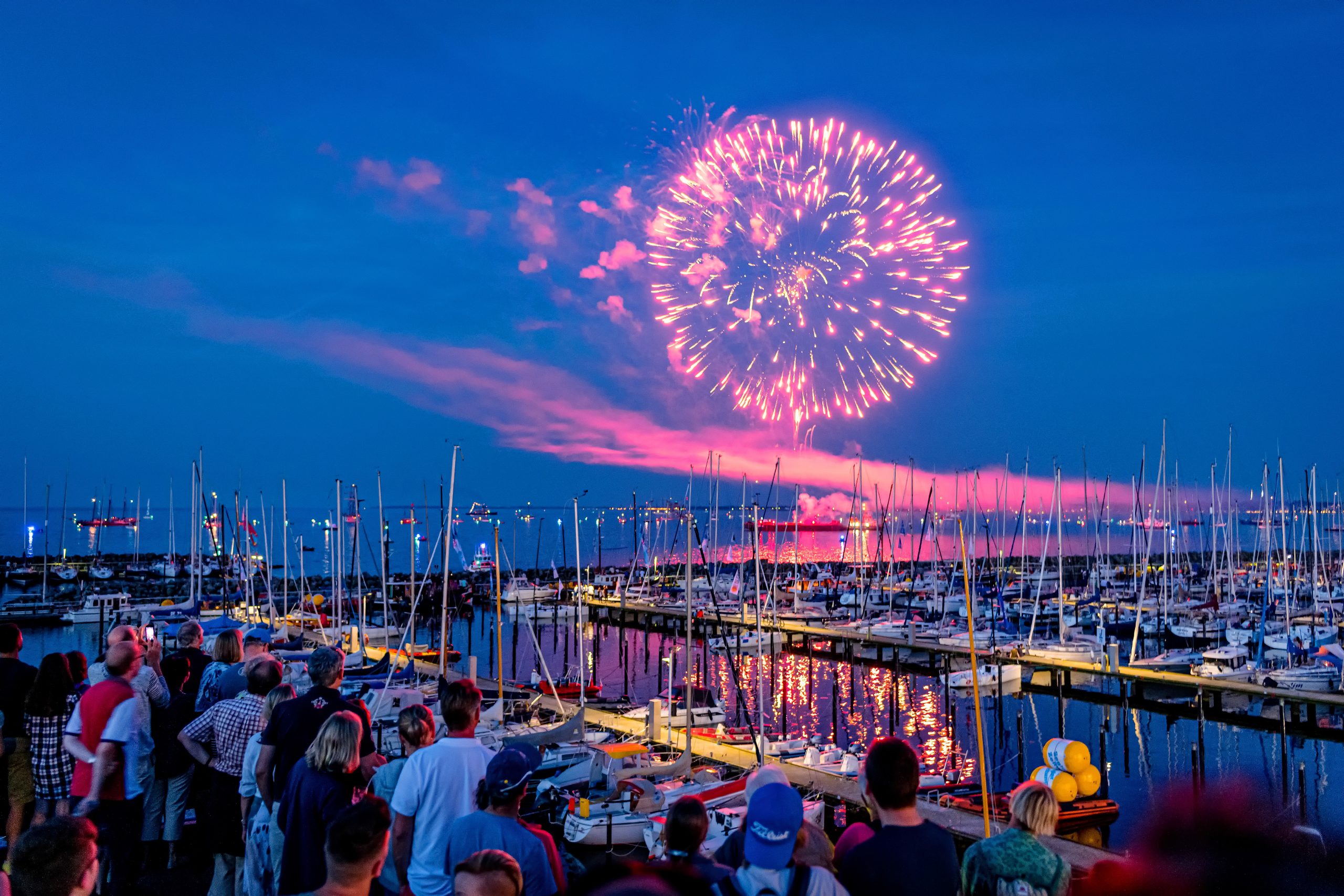

Die Kieler Woche ist eine jährlich stattfindende Segelregatta, die seit Ende des 19. Jahrhunderts in Kiel ausgetragen wird. Sie gilt als eines der größten Segelsportereignisse der Welt.[1]
In den letzten Jahrzehnten entwickelte sich zudem ein Volksfest an den Kaimauern der Großsegler, obwohl der Kern der Veranstaltung immer die Segelsportwettbewerbe geblieben sind. Neben den sportlichen Aspekten umfasst sie ein umfangreiches Programm mit über 2.100 Einzelveranstaltungen (2012), unter anderem Auftritte internationaler Künstler, die in rund 300 Konzerten auf 16 Bühnen Live-Musik bieten. Daneben gibt es auf kleineren Bühnen Darbietungen zahlreicher lokaler Gruppen. Jedes Jahr besuchen rund 3 Millionen Gäste die Kieler Woche, unter anderem auch zahlreiche Marineeinheiten aus über 10 Nationen (2012), über 3.500 Segler aus 36 Nationen (2012) und über ein Dutzend Städte-Delegationen (17 Delegationen aus 11 Nationen im Jahr 2012).[2]
Als maritimer Höhepunkt gilt die Windjammerparade (seit 1998 jährlich) am letzten Samstag der Festwoche, an der mehr als 100 Groß- und Traditionssegler, historische Dampfschiffe sowie Hunderte von Segelyachten teilnehmen. Zu Gast sind in jedem Jahr auch zahlreiche Marineschiffe und Segelschulschiffe aus anderen Ländern.
Ein weiterer Höhepunkt ist seit 2005 die jährliche Verleihung des Weltwirtschaftlichen Preises, der vom Kieler Institut für Weltwirtschaft (IfW), der örtlichen Industrie- und Handelskammer und der Stadt Kiel gemeinsam vergeben wird. Mit dem Preis werden Vordenker einer weltoffenen, marktwirtschaftlichen Gesellschaft gewürdigt.
Die Kieler Woche endet traditionell mit dem Sternenzauber über Kiel, einem Höhenfeuerwerk.
The Kiel Week (German: Kieler Woche) or Kiel Regatta is an annual sailing event in Kiel, the capital of Schleswig-Holstein, Germany. It is the largest sailing event in the world, and also one of the largest Volksfeste in Germany, attracting millions of people every year from all over Germany and neighbouring countries.[1]
Kiel Week is held annually in the last week in June, and opens officially on the preceding Saturday with the official Glasen, followed by the Holstenbummel. The "Soundcheck" is on the Friday before the official opening; it is a music festival across all the stages within the city. Kiel Week ends with a large fireworks display at 11 p.m. on Sunday, fired from pontoons or the quays at the Howaldtswerke, visible all across the Bay of Kiel.
Most ship races begin at the Olympic Harbor of Schilksee, also the center of most sporting activities during Kiel Week. As Schilksee is located outside of the inner city and most sailing competitions take place yet further out, only some races - mainly of smaller boat types - can be viewed from shore, namely from along the Kiellinie at the west coast of the Bay of Kiel.
Kiel Week usually gathers around 5,000 sailors, 2,000 ships, and about three million visitors each year. The event is organized in joint effort by the Yacht Club of Kiel, the Norddeutscher Regattaverein, the Hamburger Sailing Club, and the Verein Seglerhaus am Wannsee.
La Semaine de Kiel, (Kieler Woche en allemand), est une compétition de voile se tenant chaque année la dernière semaine complète de juin à Kiel, dans la province allemande du Schleswig-Holstein.
Lors de ce grand rendez-vous mondial de voiliers de course se déroule aussi un grand rassemblement de gréements traditionnels accompagné d'une des plus grandes fêtes populaires d'Europe.
Le 23 Juin 1882, une première régate réunit 20 yachts à Kiel1. L'empereur Guillaume II participe aux régates à partir de 1891. C'est en 1894 que l'appellation "Kieler Woche" apparaît pour la première fois dans la presse pour désigner l'événement, qui s'étend désormais sur plusieurs jours, et qui attire des participants du monde entier. On peut lire une description romancée, mais très bien documentée, de ces régates impériales telles qu'elles se déroulaient au début du XXe siècle dans le roman Les Ingénieurs du bout du monde de Jan Guillou. La semaine de Kiel sera interrompu pendant la première guerre mondiale, de 1915 à 1918, après une session particulièrement tendue en Juin 19142.
La Settimana di Kiel (in tedesco: Kieler Woche) è un evento velico annuale che ha luogo nella baia di Kiel, in Germania. È il più grande evento velico al mondo per numero di partecipanti, ed è una delle più importanti feste popolari tedesche[1]
La Settimana di Kiel si svolge ogni anno nell'ultima settimana di giugno. La manifestazione si apre il sabato precedente con il cosiddetto Glasen, ovvero il suono della sirena che ordina "mollate gli ormeggi!" o "levate l'ancora!". Segue lo Holstenbummel. In realtà il venerdì precedente l'apertura ufficiale si tiene già il "Soundcheck" : un festival musicale nelle vie del centro.
Dal 1998 ogni anno, l'ultimo sabato della Settimana si tiene la parata dei windjammer: vi partecipano più di cento grandi velieri, navi a vapore storiche e barche a vela. Inoltre ogni anni sono ospiti numerose navi da guerra e navi scuola di paesi stranieri. la Parata è spesso aperta dalla Gorch Fock, la nave scuola della marina tedesca.
La Settimana di Kiel termina con il tradizionale Sternenzauber über Kiel, uno spettacolo di fuochi artificiali che si tiene alle 11 di sera della domenica ed è visibile da tutto il Golfo di Kiel.









 Ships and Nautics
Ships and Nautics
 Schleswig-Holstein
Schleswig-Holstein



